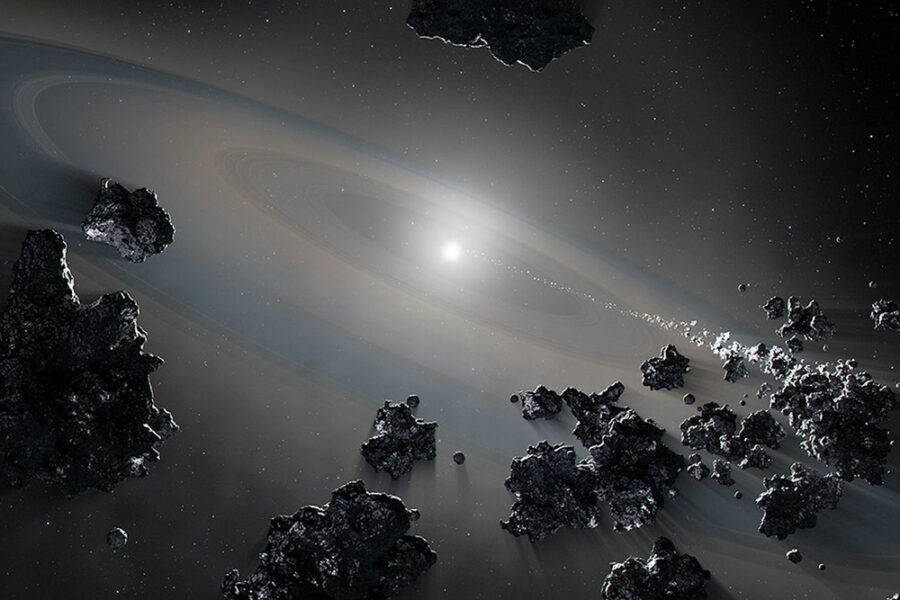Scientists have discovered one of the oldest planetary graveyards in the Milky Way: a cool white dwarf “polluted” with rocky debris.

NASA / ESA / Joseph Olmsted (STScI)
Most stars end their lives as white dwarfs — blazing-hot, roughly Earth-sized cores left naked after dying stars have sloughed off their outer layers. For planets, their suns’ death throes can quite literally be the end of the world. Dying stars have the nasty habit of vaporizing close-orbiting planets and disturbing ones farther out, creating debris that eventually falls back onto the leftover white dwarf.
Scientists now say they've discovered one of the oldest of these planetary graveyards in the Milky Way: a cool, red-hued white dwarf about 91 light-years away that's “polluted” with planetary debris.
The white dwarf described in the Monthly Notices of the Royal Astronomical Society is about 10 billion years old. It’s one of only a handful of very old white dwarfs that are burning up planetary debris, providing astronomers with a rare opportunity to examine planets of the distant past.
White, Red, and Blue
Study lead Abbigail Elms (University of Warwick, UK) and her colleagues began by realizing that there was something strange about two white dwarfs previously identified by the Gaia spacecraft.
“Both of these white dwarfs have unusual colors and brightnesses compared to other white dwarfs,” says Elms. One, WD J2147−4035, is unusually red, while the other, WD J1922+0233, has a bluer hue. To take a closer look at both, the researchers used the spectrograph of the Very Large Telescope in Chile as well as brightness measurements from the Dark Energy Survey. By analyzing the amount of light emitted at different wavelengths by the white dwarfs, they determined their compositions and temperatures.
"The first one, WD J2147−4035, is the reddest and faintest white dwarf discovered in our galaxy," says Elms. It's also very cool — the coolest polluted white dwarf yet discovered.
Old-school Cool
While white dwarfs start out blazing hot, they can only cool over time. So cool white dwarfs are old. In fact, astronomers can back-calculate the age of a white dwarf from its temperature.
Elms’ team estimates that the red-colored white dwarf has been cooling for more than 10 billion years. That would make it “the oldest star in our galaxy that’s accreting debris from orbiting planetesimals,” Elms says.
There are only a handful of polluted white dwarfs anywhere near as cool, says Siyi Xu (Gemini Observatory), who wasn’t involved in the study. But uncertainties involved in calculating age from temperature mean it’s hard to say with certainty whether the objects described by Elms’ team are also the oldest known. “That temperature is definitely the coolest, that’s for sure,” says Xu. “But then how you translate from that temperature to the exact age is somewhat model dependent.”
The bluer white dwarf is the second-coolest polluted white dwarf to be discovered. Elms’ team calculate its age to be about 9 billion years old.
Cosmological Snapshots
Observing white dwarfs consuming their planetary systems provides a rare chance to see what those planetary bodies were made of.
“[Planets] kind of get torn apart by the white dwarf,” Xu says. “By observing those white dwarfs, we can get to the chemical composition of that material.”
Elms’ team found that the debris falling into the blue star has a composition similar to that of the Earth’s continental crust. But the red star’s planets, about 1 billion years older, had a “mysterious composition,” according to Elms, with unusually high amounts of potassium and lithium.
“WD J2147−4035 gives us a little snapshot of what the galaxy was like 10 billion years ago, and WD J1922+0233 gives a snapshot of what it was like 9 billion years ago,” says Elms.
And given that more than 95% of all stars — including the Sun — will ultimately become white dwarfs, these dead stars and their torn-up planets are as much a hint at the galaxy’s past as a peek into our own future.
 4
4









Comments
Anthony Barreiro
November 10, 2022 at 10:10 pm
" ... one of the oldest of these planetary graveyards in the Milky Way: a cool, red-hued white dwarf about 90 million light-years away ... "
If it's in the Milky Way, it can't be 90 million light years away.
The arxiv preprint of this article gives Gaia astrometry distances of 27.94 ± 0.38 parsecs for WD J2147−4035, and 39.43 ± 0.41 parsecs for WD J1922+0233. So they're about 90 light years and 130 light years distant, respectively.
By the way, based on their right ascension and declination, J2147 is in Grus, and J1922 is in Aquila. I always like to know where things are in the sky, even if I can't see them in my little refractor.
https://arxiv.org/pdf/2206.05258.pdf
You must be logged in to post a comment.
Dr Jay
November 24, 2022 at 1:48 pm
Not to mention, we are highly unlikely to be able to see a white dwarf that is 90 million light-years away, even with the best instruments we currently have.
You must be logged in to post a comment.
subashi
November 14, 2022 at 3:45 am
I too wanted to point out the same. This white dwarf can't be 90 million light years away and at the same time inside the Milky Way galaxy. Can someone correct that please, in otherwise a beautiful article?
You must be logged in to post a comment.
Monica Young
November 14, 2022 at 2:10 pm
We've fixed the error, thanks for pointing it out!
You must be logged in to post a comment.
You must be logged in to post a comment.